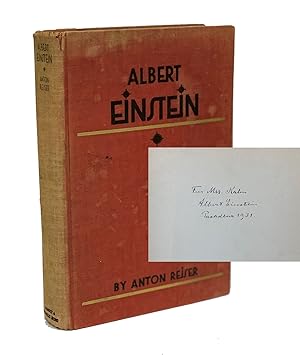Albert Einstein, First Edition (395 results)
Product Type
- All Product Types
- Books (384)
- Magazines & Periodicals (4)
- Comics
- Sheet Music
- Art, Prints & Posters
- Photographs
- Maps
-
Manuscripts &
Paper Collectibles (7)
Condition
Binding
Collectible Attributes
- First Edition
- Signed (29)
- Dust Jacket (100)
- Seller-Supplied Images
- Not Printed On Demand
Free Shipping
Seller Location
Seller Rating
-
Die formale Grundlage der allgemeinen Relativitätstheorie. Author s presentation offprint from Sitzungsberichte der Königlich Preussischen Akademie der Wissenschaften, XLI, 19 November 1914.
Published by Berlin: Königlichen Akademie der Wissenschaften, 1914., 1914
Manuscript / Paper Collectible First Edition Signed
Gr.-8vo. S. 1030-85. OBrosch. (Sitzungsberichte der königl. preussischen Akademie der Wissenschaften XLI). Leichte Knickfalten durch Versand. Geringe Gebrauchsspuren. Die erste ausführliche Darstellung der Relativitätstheorie, deren komplizierte Formeln Einstein in der bekannten endgültigen Ausgabe von 1916 vereinfachte. Vorliegende Ausgabe ist wesentlich seltener als die endgültige Fassung. Oberhalb der gedruckten Widmung Überreicht vom Verfasser" befindet sich der eigenhändige Zusatz Einsteins Mit aller Hochachtung", ferner mit eigenhändiger Formelabwandlung (S. 1069) und eigenhändigem Eintrag (S. 1072) in Tinte. Hier ist benutzt, dass auch das System K 2 dem invarianten [oder: unvariiertem] Felde angepasst ist". First edition of this extremely rare offprint inscribed by Einstein Mit aller Hochachtung" ÜBERREICHT VOM VERFASSER. Mit einer Echtheitsbestätigung vom Wiener Antiquariat Ingo Nebehay vom 6.5.1982.
-
Autograph Letter Signed [ALS] Denouncing Racial Segregation
Published by np, Princeton, NJ, 1943
Seller: Manhattan Rare Book Company, ABAA, ILAB, New York, NY, U.S.A.
Manuscript / Paper Collectible First Edition Signed
nb. Condition: Fine. First edition. EINSTEIN OFFERS STRONG AND PRESCIENT WORDS OF ENCOURAGEMENT TO THE LEADER OF THE NAACP IN THE FIGHT AGAINST RACIAL SEGREGATION AND DISCRIMINATION IN THE UNITED STATES. Background: Einstein's fight against racial discrimination in the United States: The imperative "to protect the rights of the individual. was Einstein's most fundamental political tenet. Individualism and freedom were necessary for creative art and science to flourish. Personally, politically, and professionally, he was repulsed by any restraints. "That is why he remained outspoken about racial discrimination in America. As a Jew who had grown up in Germany, Einstein was acutely sensitive to such discrimination. 'The more I feel an American, the more this situation pains me,' he wrote in an essay called 'The Negro Question' for the January 1946 issue of Pageant magazine. 'I can escape the feeling of complicity in it only by speaking out.'" (Isaacson, Albert Einstein, 505). Even more directly, in his 1946 commencement speech to Lincoln University, the first degree-granting Historically Black College and University (HBCU) in the United States, Einstein strongly denounced segregation as "an American tradition which is uncritically handed down from one generation to the next" noting that "There is separation of colored people from white people in the United States. That separation is not a disease of colored people. It is a disease of white people. I do not intend to be quiet about it." This remarkable letter - from 1943 -is one of the earliest examples of his interest in condemning racism in the United States. The letter: Dated 22 September 1943 and handwritten on his embossed Mercer Street, Princeton letterhead, Einstein writes in English to Walter F. White, the enormously influential African-American civil rights leader who led the NAACP from 1929-1955, praising him for his work and revealing his own awareness of and frustrations with racism and prejudice in America. â The text reads in full: Dear Mr. White: I have been quite impressed by the address you delivered some years ago at a meeting of the Princeton Branch of the National Association for the Advancement of Colored People. I know how hard it is to awaken the conscience even of good-hearted and well-meaning people when deep rooted prejudices are in the way. It is a great work indeed which you are doing relentlessly for the betterment of the living conditions of our Colored fellow-citizens, for justice and for the accomplishment of national unity of the American people. With sincere respect and kind wishes, Yours, Albert Einstein ------------- On April 28, 1940, White was the keynote speaker at "an inter-racial meeting sponsored by the Princeton branch of the National Association for the Advancement of Colored People" where his topic was "What Happens to Democracy When It Encounters the Color Line." (Princeton Herald, April 26, 1940). At the time, Princeton did not admit African Americans and the community was debating the question of whether or not to end segregation at the university. (Princeton, in fact, did not admit its first African-American student until the fall of 1947). Einstein -writing in 1943 -notes that he heard White speak "some years ago". Something clearly must have deeply impressed Einstein about White's speech for him to write this thoughtful letter to White over three years after the event. Note: In addition to its content, this apparently unpublished letter is also remarkable for being one of the very few letters Einstein hand-wrote in English during this period, as German was still very much his preferred tongue. Princeton: September 22, 1943. One page on Einstein's embossed Mercer Street, Princeton letterhead (7.25x10 in visible), handsomely matted and framed with a photograph of Einstein. Fine condition.
-
Autograph Letter Signed
Published by np, Princeton, 1937
Seller: Manhattan Rare Book Company, ABAA, ILAB, New York, NY, U.S.A.
Manuscript / Paper Collectible First Edition Signed
Condition: Very Good. First Edition. AN EXTRAORDINARY LETTER BY EINSTEIN TO HIS SON OFFERING LIFE ADVICE AND DISCUSSING FREUD, SHAKESPEARE, AND SCHILLER. Addressed to his son Eduard "Tetel" Einstein and signed "Papa", the letter, written in ink on both sides of one sheet, reads in full (translated from the original German): â â Dear Tetel,â â I hope by now you've received Freud's lectures from Vienna. I've read most of them myself in the past. They really made me admire the Author, but they didn't convince me that his theories were correct. â â I must admit however that, based on my personal experiences, my conviction about those theories is weakening -- I feel now that he was onto something, at least in regards to the main theses. I would have written to you sooner, but work is keeping me very busy. Even though they say that the work of a single person will not have much of an impact in the big picture, it does not diminish the passion in which we pursue our interests, and that is a good thing. â â Although personal illusions may bring warmth and joy into one's life when young, they don't last a lifetime. Life would be bleak if the work and the passion for discovery did not exist. In my free time I am currently reading Schiller's poems, which I have neglected since my youth. â â They feel a bit pompous, but at the same time they are enthralling in their choice of words and grammar. I am really happy that I picked them up again. â â I would have liked to send you another book on the top of the Freud, but didn't know which one to send -- especially because I don't get a lot of German writings anymore.â â When I have some extra free time, after finishing Schiller, I really want to start reading Shakespeare, everything from him I can get my hands on. If you like to read it too, perhaps we could discuss it at some later time?â â â Albert is a real delight -- he has been traveling up and down the country for the past 6 weeks and will have seen and experienced many interesting things. I really hope he has followed my advice and kept a journal, but I am not holding high hopes. When it comes to talking and writing he seems to be chronically constipated. With my warmest regards,â â Papa Einstein's life advice, underscoring one of his core beliefs: Einstein often stated that his main goal in life was the quest for truth, no matter how difficult and painstaking the quest. He advises Eduard in this letter that it is the pursuit and the work in attaining the goal that brings satisfaction and sustains one throughout life, even if "the work of a single person will not have much of an impact in the big picture". This, he notes, is critical to understand after the illusions of youth have succumbed to reality. Einstein, Eduard, and Freud: Eduard Einstein (nicknamed "Tete" or "Tetel"), born in 1910, was the second son of Albert and his first wife Mileva. From an early age, he became enamored with the teachings of Freud, even hanging a picture of famous psychiatrist on his bedroom wall. By the age of twenty he was diagnosed with schizophrenia and consequently was institutionalized several times throughout his life. Einstein's views of Freud's teachings were somewhat more nuanced than those of his son. Initially, Einstein did not show much interest in Freud's theories and after their first meeting in 1927, Freud famously remarked "He understands as much about psychology as I do about physics." Over the years, however, Einstein began studying Freud's works. After corresponding with Freud somewhat regularly throughout the 1930s and even collaborating with him on a project sponsored by the League of Nations ("Why War?", 1932), Einstein began to move from a deep skepticism to - as indicated in this letter - a growing acceptance. By 1936 - just before this letter was written - Einstein sent birthday greetings to Freud, acknowledging: "Until recently I could only apprehend the speculative power of your train of thought, together with its enormous influence on the Weltans.
-
First edition. 'the greatest blunder of my life'. An important group of photographs documenting Einstein's second visit to America, and his first to the California Institute of Technology, which began at the end of December 1930. The main purpose of the visit was to discuss Edwin Hubble's observations, made in 1929 with the 100-inch telescope at the Mount Wilson Observatory (then the largest telescope in the world), which showed that light from distant nebulae (galaxies) was red-shifted, indicating that the universe was expanding. Einstein had believed that the universe is static, and had introduced his 'cosmological constant' into his equations of general relativity to allow for a static solution. When Einstein met Hubble at the Mount Wilson Observatory in January and February 1931, he was visibly moved with Hubble's discovery and reportedly said, with tears in his eyes that "It was the most beautiful and satisfying interpretation of astronomical science." In light of the new evidence, Einstein published a paper two months later renouncing the concept of a cosmological constant, whose invention Einstein denounced as "the greatest blunder of my life." Einstein was accompanied on his visit by Walther Mayer (1887-1948), who had been appointed as his mathematical assistant in 1929. Mayer and Einstein worked together on several approaches towards a unified field theory. "On the way over, [Einstein] and his mathematical calculator, Walther Mayer, holed up, working on revisions to his unified field theory, in an upper-deck suite with a sailor guarding the door" (Isaacson, p. 368). Two of the photographs are of Einstein at Mount Wilson, one with Mayer and the observatory's director Walter Adams (1876-1956), who had confirmed Einstein's prediction of the gravitational red-shift (although his observations were later shown to be faulty); the other with Mayer and solar physicist Charles St. John (1857-1935) who had assisted Hubble with his red-shift observations. Another photograph shows Einstein between fellow Nobel Laureates Albert Michelson (1852-1931) and Robert Millikan (1868-1953), Caltech's "chairman of the executive council" (effectively its president). Together with Edward Morley, Michelson had in 1887 carried out the famous Michelson-Morley experiment which failed to detect evidence of the existence of the luminiferous ether; this provided crucial evidence for the early acceptance of special relativity. On this trip, Einstein "paid tribute to the aging Michelson, carefully praising his famous experiments that detected no ether drift, without explicitly saying that they were a basis for his special theory of relativity" (Isaacson, p. 372). "In the early 1930s [Einstein] came to California specifically to consult with scientists at the California Institute of Technology. Few members of the general public understood the nature of his visits, but they idolized him all the same. From the moment his boat docked in San Diego on December 31 1930, the reception accorded him by Californians was one part show business, one part hero worship, and one part genuine affection. Groups of children dressed in blue and white middies serenaded him and thrust wreaths of flowers into his hands, two bands struck up tunes, and in Los Angeles a theatrical group, the Yale Puppeteers, opened a play called Mr. Noah in which the ark landed on Mt. Wilson instead of on Mt. Ararat . "As early as 1913, Einstein was looking for experimental verification for the correctness of his theory of general relativity, and he had been in correspondence with Caltech's George Ellery Hale, asking him to make an astronomical measurement. He was anxious to know if Hale could detect the influence of the sun's gravitation field upon a light ray. Hale replied that in order to try he needed a solar eclipse. The experiment was finally carried out in 1919 by two British expedition teams and again in 1922 by an American team of astronomers - and it did confirm the theory of general relativity. "There were cosmological implications in this theory, and they attracted a lot of attention in the 1920s and 1930s - nowhere more than at Caltech. Millikan had been urging Einstein to visit the campus for some time, and, in the fall of 1930, he agreed to spend the winter quarter in Pasadena. Not only would he be able to discuss his theory and its interpretation with distinguished scientists; he would also be meeting old friends again - Richard Tolman, the cosmologist; Paul Epstein, the theoretical physicist; and Theodore von Karman, the aerodynamicist . "The new Athenaeum at Caltech was the setting for many dinners to honor Einstein. At the first, on January 15, 1931, the guests included the physicist and Nobel Laureate A. A. Michelson and 200 members of the California Institute Associates. Several weeks later, a second dinner was held at which all the astronomers from the Institute and the Mt. Wilson Observatory were present. Edwin Hubble was there, as was Charles E. St. John, who verified the third prediction of the theory of general relativity [the gravitational red-shift]. Colleagues came from Berkeley, including Tolman's close friend and co-author G. N. Lewis, who wrote to say he was coming with a friend - though not without some mildly humorous trepidation. As he put it in his letter to Tolman: 'I have just accepted an invitation from Oppenheimer to drive me down. Do you think I should take out accident insurance?' "Einstein was not without a sense of humor himself. At a farewell luncheon in his honor on February 24, 1931, which was sponsored by the Pasadena Chamber of Commerce, he said: "I want to thank the extraordinary group of scholars in the fields of physics and astronomy who have afforded me glimpses of their work. They have conducted me not only into the world of atoms and crystals, but also to the surface of the sun and into the outermost depths of space. There I saw worlds which are flying away from us with incomprehensible rapidity, in spite of the fac.
-
Autograph Manuscript Signed
Published by np, np, 1930
Seller: Manhattan Rare Book Company, ABAA, ILAB, New York, NY, U.S.A.
Manuscript / Paper Collectible First Edition Signed
Condition: Fine. First edition. EINSTEIN ON THE CONCEPT OF PEACE: A POWERFUL AUTOGRAPH STATEMENT IN EXCEPTIONALLY LARGE FORMAT. â . Translated from the original German: "No person has the moral right to call himself a Christian or Jew so long as he is prepared to engage in systematic murder at the command of an authority, or allow himself to be used in any way in the service of war or the preparation for it." Starting in 1925, the French Academy began sending large (11.5x16.5) sheets to important scientists, writers, and intellectuals asking them to write on the sheet a statement on the concept of peace for possible inclusion in an anthology. (The World League for Peace later released a limited edition of prints from the submissions under the title Pax Mundi: livre d'or de la paix.) This is Einstein's unique manuscript submission. A highly unusual format with exceptionally large Einstein signature (2.25 in / 6 cm) of an important Einstein statement, consistent with his life-long dedication to pacifism. c.1925-1930. One large folio page (11.5 x 16.5 inches). In German. Fine condition.
-
Einstein at Work [Suite of Seven Photographs]
Published by np, New York, 1980
Seller: Manhattan Rare Book Company, ABAA, ILAB, New York, NY, U.S.A.
First Edition Signed
Clamshell box. Condition: Fine. First edition. EXTREMELY RARE COMPLETE SUITE OF SEVEN LARGE SILVER PRINTS FROM EINSTEIN'S FAMOUS PHOTO SHOOT AT PRINCETON WITH ROMAN VISHNIAC. Each print is signed by Vishniac and dated "At Princeton 1942" in his hand below the image and numbered on the back. "One day [Vishniac] decided to visit Albert Einstein at Princeton to offer greetings from mutual friends in Berlin. Uninvited, he hoped Einstein would pose for a portrait, but Einstein had little interest. Vishniac recalled: It was a singular experience. An idea had suddenly come to him, and the room was filled with the movement of the great man's thought. I waited several minutes, and then when I saw that he did not intend to say anything more to me and that he was off in a world of his own, I started taking pictures. Einstein later admitted that a Vishniac photograph taken that day was his favorite portrait" (Encyclopedia of Twentieth-Century Photography). Vishniac provided details about this portolfio in a letter to an original recipient (the letter is not included here), explaining: The size of the edition's limitation is uncertain due to my age and only spare time to make them. The most expensive portfolios - Ansel Adams, Kertesz - are limited in large numbers I can never measure up - 999, 1001 and similar. The originality of Portfolio "Einstein" consists of its special character. It is made not to get images, but the feeling that you are present during the creativity by the Great Man. All pictures are made with "hidden camera" method. The value of this portfolio is great and can hardly be estimated today. Princeton/New York: 1942 (negatives); 1980 (silver prints). Elephant folio clamshell box (approx. 17x21 in.) housing seven silver prints. Image size: approx. 10.25 x 13.25 in.; with matte, 16x20 in.) A few minor blemishes to box. Photos in fine condition. RARE.
-
Typed Letter Signed with Autograph Annotation
Published by np, Princeton, NJ, 1953
Seller: Manhattan Rare Book Company, ABAA, ILAB, New York, NY, U.S.A.
Manuscript / Paper Collectible First Edition Signed
custom folder. Condition: Very Good. First edition. TOWARDS THE END OF HIS LIFE, EINSTEIN WRITES TO ONE OF HIS FRIENDS FROM THE PATENT OFFICE CONCERNING ONE OF THE CENTRAL STRUGGLES OF HIS SCIENTIFIC LIFE. COMMENTING ON THE WORK OF DIRAC, EINSTEIN ADMITS THAT ALTHOUGH HE "CAN'T TAKE A STATISTICAL FOUNDATION OF PHYSICS SERIOUSLY" HE FINDS IT "DIFFICULT TO MOVE BEYOND IT". Background: Einstein's struggle with accepting a strictly statistical quantum theory has been one of the most discussed and debated topics of twentieth-century physics. When introduced to the statistically-based quantum mechanics of Heisenberg, Born, and Jordan in 1926, Einstein famously wrote to Max Born that "Quantum mechanics is certainly imposing. But an inner voice tells me that it is not yet the real thing. The theory says a lot, but does not really bring us any closer to the secret of the 'old one.' I, at any rare, am convinced that He is not playing at dice." (Einstein letter to Born from 4 December 1926.) From the onset, "Einstein regarded the quantum theory as descriptively incomplete. What he meant was that, in typical cases, the probabilistic assertions provided by the theory for an individual quantum system do not exhaust all the relevant and true physical assertions about the system. Put briefly, according to Einstein, the typical statistical story told by quantum theory is not the whole story." (Arthur Fine, "What is Einstein's Statistical Interpretation, or, Is It Einstein for Whom Bell's Theorem Tolls?"). Einstein's discomfort with the new theory haunted him for the next three decades and his challenges to the theory were the cause of some of the most fertile and defining moments of modern science, notably the celebrated "Bohr-Einstein debates" begun at the Fifth Solvay Conference (1927) and his monumentally influential "EPR" paper of 1935 ("Can Quantum-Mechanical Description of Physical Reality Be Considered Complete?", written with Boris Podolsky and Nathan Rosen). As late as 1949, in his "Reply to Criticisms" (published in Albert Einstein: Philosopher-Scientist), Einstein notes that Born and Wolfgang Pauli, in their contributions to the volume "deprecate the fact that I reject the basic idea of contemporary statistical quantum theory, insofar as I do not believe that this fundamental concept will provide a useful basis for the whole of physics" and spends the majority of the essay explaining his position (and distinguishing between his acceptance of the model for "ensembles of systems" while still rejecting it for an "individual physical system"). The letter: Dated September 12, 1953, and written to his old colleague at the patent office in Bern, Joseph Sauter, the letter (translated from the original German) reads in full: Dear Mr. Sauter, If I am able to, I will gladly assist Mr. Keberle. I have heard of you often from my old friend Besso and I have also received a manuscript which deals critically with [handwritten] Dirac's presentation of the statistical approach to quantum theory. I have not been able to judge it myself because it is simply impossible for me to take a statistical foundation of physics seriously. But I have to admit that it is difficult to move beyond it. Yours sincerely, [signed] A. Einstein. Albert Einstein. The recipient, Joseph Sauter, worked with Einstein at the Bern Patent office during the years he was developing the ideas for his revolutionary papers of 1905. "Among his colleagues at the Patent Office Einstein discovered one with similar scientific interests-Dr. Josef Sauter, a French-Swiss, who had also studied at the Polytechnic and who had been Professor Weber's chief assistant for a while. Sauter, like Einstein, tried to fill the gaps in the Polytechnic's syllabus by private study, so that Einstein was able to discuss with him Maxwell's thermodynamics and Helmholtz's and Hertz's theoretical concepts. The two also discussed Einstein's publications on thermodynamics with the result that Sauter discovered a mistake in them, which Einstein accepted 'without being.
-
Relativity, the Special and the General Theory
Published by Methuen & Co., 1920
Seller: CASSIUS&Co., London, United Kingdom
Book First Edition
Hardcover. Condition: Near Fine. 1st Edition. First English edition of Einstein s theory of Relativity, published by Methuen & Co., 1920, translated by Robert L. Lawson. Highly scarce, particularly in an unrestored dustwrapper and with the binding relatively unfaded, as here. A signature clipped from the top of the half-title, but overall a remarkably fresh copy.
-
Strahlungs-Emission und Absorption nach der Quantentheorie', pp. 318-323 in: Verhandlungen der Deutschen Physikalischen Gesellschaft, Jahrg. 18, Nr. 13/14, 30 July 1916
Published by Druck und Verlag von Friedr. Vieweg and Son, Braunschweig, 1916
First Edition
First edition. DISCOVERY OF STIMULATED EMISSION OF RADIATION THE PRINCIPLE OF THE LASER INSCRIBED BY EINSTEIN TO A FELLOW NOBEL LAUREATE. First edition, complete journal issue in original printed wrappers, inscribed by Einstein to fellow Nobel Laureate Walther Bothe. "This work represents a major step forward in quantum theory" (Calaprice, p. 297). It introduced the concept of stimulated emission of radiation, the theoretical basis for the laser; it also contained a new derivation of Planck's radiation law which provided, as a by-product, a justification of the frequency rule forming the basis of Bohr's theory of atomic spectra. "According to Albert Einstein, when more atoms occupy a higher energy state than a lower one under normal temperature equilibrium, it is possible to force atoms to return to an unexcited state by stimulating them with the same energy as would be emitted naturally" (Britannica). This is 'stimulated emission.' "To claim that Einstein almost invented the laser would be an exaggeration, but the laser's underlying mechanism, stimulated emission of radiation, was a creation of his radiation theory" (Kleppner, pp. 32-33). "During the summer of 1916, less than a year after he had completed the general theory of relativity, Einstein made a new, major contribution to the quantum theory. The two papers he wrote then deal with the quantum theory of radiation by arguments that do not depend on the classical electromagnetic theory, as had all earlier treatments of Planck's radiation law . When Einstein returned to the radiation problem in 1916, the quantum theory had undergone a major change. Niels Bohr's papers had opened a new and fertile domain for the application of quantum concepts - the explanation of atomic structure and atomic spectra. In addition, Bohr's work and its generalizations by Arnold Sommerfeld and others constituted a fresh approach to the foundations of the quantum theory of matter" (DSB). In this paper, "Einstein considers a system of atoms in equilibrium with an external radiation field. An atom can change its internal energy state by absorbing or emitting radiation. Einstein introduces three basic assumptions about these exchanges of energy between matter and field. First, the probability of absorption of radiation is proportional to the radiation density. Second, there are two kinds of emission processes: one - spontaneous - following a law like that of radioactive decay; the other - stimulated - induced by the radiation field and with probability proportional to the radiation density. Third, at equilibrium the atoms are distributed among their internal states according to the Boltzmann distribution law. From these assumptions Planck's law follows in a simple way. Einstein was very pleased with his derivation, which he characterized in a letter to Besso: 'An amazingly simple derivation of Planck's formula, I should like to say the derivation.' As a bonus from his derivation Einstein found that the energy difference between two internal energy states of the atom had to be equal to hv, with v the frequency of the radiation absorbed or emitted in transitions between these two states, thus confirming one of the postulates of Niels Bohr's theory of spectra" (Papers 6, xxiii-xxiv). "Einstein meant the second part of this study, a proof of the oriented character of the emission process, to be his most essential contribution to quantum radiation theory [this second paper was published later in 1916 as 'Zür Quantentheorie der Strahlung']. Instead, Bohr gave more importance to the new deduction of the blackbody law; for this deduction reinforced the basic assumptions of his atomic theory and completed them with a statistical description of radiation processes" (Darrigol, p. 120). Provenance: Inscribed by Einstein on front wrapper, "f[ür]. Dr Bothe", i.e., Walther Bothe (1891-1957). "In 1929, in collaboration with W. Kolhörster, Bothe introduced a new method for the study of cosmic and ultraviolet rays by passing them through suitably arranged Geiger counters, and by this method demonstrated the presence of penetrating charged particles in the rays and defined the paths of individual rays. For his discovery of the 'method of coincidence' and the discoveries subsequently made by it, which laid the foundations of nuclear spectroscopy, Bothe was awarded, jointly with Max Born, the Nobel Prize in Physics 1954" (). While Einstein commended Planck's epoch-making derivation of his radiation law in 1900, which ushered in the quantum era, he had also noted its limitations. Einstein also saw inconsistencies in Planck's derivation of his law. For Einstein this inconsistency was no reason to reject Planck's quantum theory, but it was a reason to study the foundations of traditional radiation theory and if needed, revise them. "As [Einstein] had noted in 1906, Planck's derivation of the [Rayleigh-Jeans law] uν = (8Ï Î½2/c3) kT between average resonator energy [uν] and radiation spectrum [ν] only applied to classical resonators [T is the temperature, k is Boltzmann's constant]. A new, quantum-theoretical picture of the interaction between matter and radiation was needed. Einstein found it in the summer of 1916, after the completion of his general theory of gravitation left him more time for quantum meditation. "The new picture presumably emerged from a combination of three elements: Einstein's derivation of the law of photochemical equivalence, his analogy between quantum states and chemical species, and Niels Bohr's theory of atomic spectra. According to Bohr, atoms and molecules can only exist in a series of quantum states S0, S1, . . . Sn, . . . with well-defined energies E0, E1, . . . En, . . . Their interaction with radiation occurs through quantum jumps with characteristic values of the frequency of the emitted or absorbed radiation. Regarding the quantum states as chemical species and remembering his photochemical reasoning, Einstein knew that he could derive Wien's law by balancing.
-
Zur allgemeinen Relativitätstheorie [with:] Zur allgemeinen Relativitätstheorie (Nachtrag). Offprint from Sitzungsberichte der Preussischen Akademie der Wissenschaften XLIV, November 4, 1915 & XLVI, November 11, 1915
Published by Königlichen Akademie der Wissenschaften, Berlin, 1915
First Edition
First edition. EINSTEIN'S COMPLETION OF THE GENERAL THEORY OF RELATIVITY. First editions, very rare offprint, of the first two of the papers published in November 1915 that document Einstein's final version of the general theory of relativity. "In the half century and more of Einstein's work in science, one discovery stands above all as his greatest achievement. It is his general theory of relativity" (Norton). "There was difficulty reconciling the Newtonian theory of gravitation with its instantaneous propagation of forces with the requirements of special relativity; and Einstein working on this difficulty was led to a generalization of relativity - which was probably the greatest scientific discovery that was ever made" (Dirac, quoted in Chandrasekhar, p. 3). Einstein's special theory of relativity (1905) showed that the laws of physics are the same in all inertial (i.e., non-accelerating) frames of reference. It was then natural to ask whether it was possible to extend this principle of relativity to the more general case of frames of reference in arbitrary states of motion. This problem became linked to a theory of gravitation with Einstein's 'equivalence principle' of 1907, according to which the effects of gravity are locally equivalent to those of accelerated motion. Einstein's first steps towards a geometrical theory of gravitation were taken in August 1912, when his friend Marcel Grossmann provided the necessary mathematical tools. "Some time between August 10 and August 16, it became clear to Einstein that Riemannian geometry is the correct mathematical tool for what we now call general relativity theory. The impact of this abrupt realization was to change his outlook on physics and physical theory for the rest of his life" (Pais, p. 210). The resulting 'Entwurf' theory (1913) had much in common with the final theory of 1915, but based on a fallacious argument Einstein abandoned the requirement that the theory should be 'generally-covariant', i.e., that arbitrary frames of reference should be allowed. "After three years of fruitless peregrinations, the revelation came to Einstein that he had been constantly on the wrong track, although in 1913 he had been so near to the right solution" (Lanczos, p. 211). On November 4, 1915 he presented to a plenary session of the Prussian Academy a new version of general relativity, 'Zur allgemeinen Relativitätstheorie,' "based on the postulate of covariance with respect to transformations with determinant 1", and stated that he had "completely lost confidence" in the 'Entwurf' equations. On November 18, he published his calculation of the precession of the perihelion of Mercury based on the new theory: its agreement with observation confirmed that the theory was correct (the Entwurf theory predicted half the observed value of the precession). "In June 1905, while still a patent examiner in Bern, Einstein submitted his famous work on the electrodynamics of moving bodies to the Annalen der Physik. This work contained his special theory of relativity, in which he asserted the equivalence of all inertial frames of reference as a fundamental postulate of physics. The question which then naturally arose was whether it was possible to extend this principle of relativity to the more general case of frames of reference in arbitrary states of motion. But he could find no workable basis for such an extension, until he tried to incorporate gravitation into his new special theory of relativity for a review article in 1907 ['Uber das Relativitätsprinzip und die ausdemselben gezogenen Folgerungen,' Jahrbuch der Radioaktivitat und Elektronik 4 (1907), 411-62]. The difficulties of this task led him to a new principle, later to be called the 'principle of equivalence.' "On the basis of the fact that all bodies fall alike in a gravitational field, Einstein postulated the complete physical equivalence of a homogeneous gravitational field and a uniform acceleration of the frame of reference. This extended the principle of relativity to the case of uniform acceleration. It also foreshadowed the problem whose complete solution would lead him to his general theory of relativity: the construction of a relativistically acceptable theory of gravitation, based on the principle of equivalence" (Norton, p. 258). One application of the equivalence principle proved crucial to the subsequent development of his ideas on general relativity. Einstein considered an observer standing on a rotating disc - a non-inertial (accelerating) reference frame. According to special relativity, measuring rods aligned with the circumference of the disc will contract due to their motion, whereas measuring rods positioned along the radius of the disc will not. Hence the ratio of the circumference of the disc to its diameter will be less than Ï . "The spatial geometry for the rotating observer is therefore non-euclidean. Invoking the equivalence principle, Einstein concluded that this will be true for an observer in a gravitational field as well. This then is what first suggested to Einstein that gravity should be represented by curved space-time. "To describe curved space-time Einstein turned to Gauss's theory of curved surfaces, a subject he vaguely remembered from his student days at the ETH in Zürich. He had learned it from the notes of his classmate Marcel Grossmann. Upon his return to his alma mater as a full professor of physics in 1912, Einstein learned from Grossmann, now a colleague in the mathematics department of the ETH, about the extension of Gauss's theory to spaces of higher dimension by Riemann and others. Riemann's theory provided Einstein with the mathematical object with which he could unify the effects of gravity and acceleration: the metric field" (Janssen, p. 65). The first product of this collaboration was the Entwurf einer verallgemeinerten Relativitätstheorie und einer Theorie der Gravitation, published before the end of June 1913, which contained many of the essential features of the.
-
Photograph Signed
Published by np, Princeton, NJ, 1954
Seller: Manhattan Rare Book Company, ABAA, ILAB, New York, NY, U.S.A.
First Edition Signed
nb. Condition: Fine. First edition. EXTREMELY RARE AND BEAUTIFUL SIGNED PHOTOGRAPH OF EINSTEIN BY FREDERICK PLAUT. SIGNED ON THE IMAGE BY EINSTEIN: "A. Einstein 54". A fine photograph of Einstein in 1954, a year before his death, sitting in his Princeton home surrounded by books and holding his pipe, gazing slightly away from the camera. In his 1964 collection of photographs, The Unguarded Moment, the photographer Frederick Plaut explains the circumstances of his evocative photo of the elderly Einstein: "There must be a moment in every professional photographer's life when he is so in awe of his subject that he can scarcely focus his camera. That moment for me was when I met Albert Einstein at his home in Princeton. Certainly the great man was not formidable; he greeted my wife and me graciously, and proceeded to chat with her while I went to work. I remember that she asked him about his music and when he told her that he no longer played his violin she murmured, 'That's too bad.' He smiled, 'Ah, no. It would have been too bad if I went on.' In the final moments of our visit, Einstein looked at me very seriously. 'I hope,' he said, 'you can sell these pictures for a good price.' Astounded, I blurted out: 'Oh, no, Sir. I have nothing to sell. I just wanted to photograph you.' His face clouded. 'Not sell them? If I had known that I never would have let you take them.' After we left, I realized the significant of a delightful remark attributed to Mrs. Einstein. Someone once asked Mrs. Einstein whether she understood Professor Einstein's theory of relativity. She answered without hesitation, 'No, but I understand Professor Einstein'" (Frederick Plaut, The Unguarded Moment, A Photographic Interpretation). The photographer Frederick Plaut moved to the United States from Europe in 1940. After being "discovered" by the legendary photographer Edward Steichen, Plaut soon was invited to exhibit in numerous exhibitions. "At the Museum of Modern Art his photographs have been shown in many exhibitions including: 'The Family of Man,' 'Music and Musicians,' 'The Exact Instant' and others. Plaut's work has appeared in Time, Life, Esquire, Look, Saturday Review, Vogue, U.S. Camera, Modern and Popular Photography, andRealities, et al" (The Unguarded Moment). Provenance: Acquired directly from the family of the original recipient, Arthur Klein, with the original mailing envelope (stamped "Jan 27 '54") from The Institute for Advanced Study in Princeton, where Einstein was working at the time. Arthur Klein is primarily known for founding with his wife Luce, Spoken Arts, a highly influential company formed in the 1950s that created and distributed recordings of the works of famous writers and artists, usually reading from their own works. Princeton, NJ: 1954. Silver gelatin print, approximately 4.75 x 6.75 inches. With Plaut's studio stamp on verso. Fine condition with Einstein signature - nicely centered at the base of the photograph - particularly strong. As Plaut mentioned in his account of the photographic session, he never intended to sell this photograph and it is likely very few of these photos were printed and distributed. EXTREMELY RARE: WE CAN FIND NO OTHER EXAMPLE OF THIS PHOTOGRAPH SIGNED BY EINSTEIN.
-
Carte postale autographe signée adressée au Professeur Ludwig Hopf
Publication Date: 1910
First Edition Signed
Pas de couverture. - Zurich 21 juin 1910, 9x14cm, une carte postale. - | Einstein écrit à « l'ami des plus grands génies de son temps » | Carte postale autographe signée d'Albert Einstein adressée à Ludwig Hopf, 18 lignes écrites au verso et recto, adresse également de la main d'Einstein. Tampon postal indiquant la date du 21 juin 1910. Publiée dans The Collected Papers of Albert Einstein, Volume 5: The Swiss Years: Correspondence, 1902-1914, Princeton University Press, 1993, n°218, p. 242. *** Exceptionnelle et très esthétique carte d'Albert Einstein à « l'ami des plus grands génies de son temps » - selon Schrödinger - le mathématicien et physicien Ludwig Hopf, qui permit la rencontre d'Einstein avec un autre génie du XXe siècle : Carl Jung. Le maître invite ici son élève à un dîner comptant au nombre des invités le scientifique Max Abraham, futur grand rival des années zurichoises et fervent opposant à la théorie de la relativité d'Einstein. Le destinataire de cette carte, Ludwig Hopf, rejoint Einstein en 1910 en tant qu'assistant et élève à ses séminaires de physique et de théorie cinétique à l'Université de Zürich. Ils signent deux articles fondamentaux sur les aspects statistiques de la radiation et donnent leurs noms à la force de résistance « Einstein-Hopf ». Leurs échanges épistolaires retracent le complexe cheminement des travaux d'Einstein sur la relativité et la gravitation, témoignant de leur grande complicité et du précieux apport de Hopf dans les recherches du maître. Quelques mois après l'écriture de cette missive, Hopf trouvera même une erreur dans les calculs d'Einstein sur les dérivées de certaines composantes de la vitesse que ce dernier corrigera dans un article l'année suivante. Ils forment également un duo musical et interprètent les grands génies de la musique, Hopf accompagnant au piano le violon du maître sur des morceaux de Bach et Mozart. Einstein invite par cette carte son élève et ami Hopf à un dîner avec Max Abraham, à l'aube d'une controverse scientifique majeure qui les opposera à partir de 1911. La théorie de la relativité restreinte selon Abraham ne convaincra pas Einstein qui soulignera le peu de moyens de vérification par l'observation et son manque de prédiction de la courbure gravitationnelle de la lumière. En 1912, leur différend deviendra public par publications interposées. Abraham ne reconnaîtra jamais la validité de la théorie einsteinienne. Au cours de leurs brillants échanges artistiques et intellectuels, Hopf a sans doute réussi là où Freud avait échoué comme il lui avouera dans une lettre : « Je romprai avec vous si vous vous glorifiez d'avoir converti Einstein à la psychanalyse. Une longue conversation que j'ai eue avec lui il ya quelques années m'a montré que l'analyse lui était tout aussi hermétique que peut m'être la théorie de la relativité. » (Vienne, 27 septembre 1931). Fervent adepte de la psychanalyse, Hopf est en effet connu pour avoir présenté le célèbre psychanalyste Carl Jung à Einstein. Hopf et son maître partiront tous deux pour l'Université Karl-Ferdinand de Prague en 1911, où ils fréquenteront l'écrivain Franz Kafka et son fidèle ami Max Brod dans le salon de Mme Fanta. Avec l'avènement du régime nazi, les destins de ces deux théoriciens de la mécanique du monde seront marqués par les persécutions et l'exil, Einstein se réfugiant tout d'abord en Belgique, Hopf en Grande-Bretagne après sa mise à pied en 1934 de l'université d'Aix-la-Chapelle à cause de ses origines juives. Les deux savants continueront à entretenir une prolifique correspondance au c ur de la tourmente, Einstein suggérant à Hopf l'ouverture d'une université à l'étranger pour les étudiants allemands exilés. Hopf s'éteindra peu de temps après avoir pris la chaire de mathématiques du Trinity College de Dublin en juillet 1939. Précieuse invitation du grand physicien à l'ultime dîner réunissant la "vieille école" scientifique symbolisée par Max Abraham, à l'aube de la publication de la théorie de la relativité.
-
Albert Einstein: Philosopher-Scientist
Published by Evanston: Library of Living Philosophers,, 1949
Seller: 19th Century Rare Book & Photograph Shop, Stevenson, MD, U.S.A.
Book First Edition Signed
Hardcover. Condition: Fine. 1st Edition. Original brown cloth, top edge gilt, publisher s slipcase. Very fine, with the fragile slipcase in excellent condition. A superb copy. FIRST EDITION. One of 760 numbered copies signed and dated by Einstein. This important volume contains Einstein s autobiography, specially written for the book, a bibliography of his works, twenty-five scientists discussions of Einstein s work and achievements, with Einstein s replies. Contributors of essays include Niels Bohr, Max Born, Wolfgang Pauli, and Kurt Godel. I. I. Rabi s review in Science hailed this as a most important and significant volume. It is most difficult to get scientists to write simply and clearly about the fundamentals of their science and the leading philosophical ideas that guide them. In this book there is played out a great scientific drama of the last two decades. The book starts with an intellectual autobiography by Einstein himself. He satirically calls it his obituary. I know of no other to compare with it. Neither Newton nor Maxwell nor any of the other great giants of physics had his Schilpp [the editor] to catalyze such an effort. After reading Einstein s article one realizes the great loss this is to scientific culture (Science, 21 April 1950). This is an especially fine signed copy of an important book in the Einstein canon. Signed by Author(s).
-
Typed Letter Signed
Published by np, Princeton, 1934
Seller: Manhattan Rare Book Company, ABAA, ILAB, New York, NY, U.S.A.
First Edition Signed
No Binding. Condition: Very Good. 1st Edition. AN IMPORTANT SIGNED LETTER (in English) by Einstein, revealing his reservations of associating with communism even in the fight against fascism. Written from Princeton, NJ, to Professor Albert Sprague Coolidge of Harvard University, and dated February 16, 1934, the letter reads: My dear Professor Coolidge: I had an opportunity of meeting personally Lord Marley and has [sic] very favorably impressed by his personality. It became known to me that he sympathizes with the Russian Government, i.g. with the Russian communist party and that the committee for which he is active is influenced by communists. The problem as to the attitude which is advisable to be taken towards this committee is rather complicated. On the one hand, the world-wide danger of fascism makes it necessary that all enemies of fascism cooperate; on the other hand, an action which has communist leanings might endanger that fight since the important task undertaken in defense of culture and civilization may be linked up with interests of a political party. I, myself have severed my connections with the committee, which, with my permission had used my name up to the end of last year. It seems to me advisable to take an attitude as follows: to help their action against fascism, but not to identify oneself with the committee. Very truly yours, [signed] A. Einstein P.S. I wish you would be good enough to use this strictly confidentially. In 1934, Lord (Baron) Marley (Dudley Leigh Aman), toured the United States to raise funds for his association, the World Committee for the Victims of German Fascism. Marley, through his committee, was "passionately advocating a scheme for which he was to become an international figurehead - resettlement of oppressed German and Polish Jews in the Jewish Autonomous Region" in Siberia. He published a book, "The Brown Book of the Hitler Terror and the Burning of the Reichstag, sponsored by the World Committee and with an Introduction written by Lord Marley himself, [which] was the first popular exposé of what was happening in Hitler's Germany. It documented the destruction of political parties, trade unions and universities, book-burning, and the building of concentration camps. "At a fundraising dinner held in his honour in New York in February 1934 [where Einstein presumably met him, just before writing this letter], Marley opened the Brown Book and 'speaking quietly, declaring that he did not intend to harrow', read aloud to his audience of 600 American Jews some of the collected evidence of Nazi repressions. Here were documentary records of what was happening in Germany - a substantiation of the brutality that hitherto had had no distinct form in the mind of the American Jewish public. What before had been the subject of a growing fear mingled with disbelief was now being presented as hard fact and supported with detailed evidence. The New York Times (8 February 2005) reports the audience being 'startled' by the disclosures, and the night ending with $3,500 raised for the World Committee" (The Jewish Quarterly, No. 198). Einstein was correct to be suspicious of Marley's activities, for it was later determined that the "World Committee" was indeed a Communist front; Einstein, writing here to Coolidge in 1934, was prescient about the motives of the committee. This letter, in addition to underscoring Einstein's passionate stance against fascism, is particularly important as documentary evidence of Einstein's caution about having any dealings with communism, especially considering that the U.S. FBI, worried about Einstein's political leanings, kept a file on Einstein that grew to 1427 pages. Princeton, NJ: February 16, 1934. One (8.5 x 11 in.) page. Envelope folds, minor spotting. An outstanding letter with important and revealing content.
-
Albert Einstein: A Biographical Portrait.
Published by Albert & Charles Boni, New York, 1930
Seller: Raptis Rare Books, Palm Beach, FL, U.S.A.
First Edition Signed
First edition of this Einstein biography written by Rudolf Kayser, a German literary historian and husband to Albert Einstein's stepdaughter Ilse under the pseudonym Anton Reiser. Octavo, original cloth, frontispiece of Einstein. Inscribed by Albert Einstein with an original poem on the front free endpaper in German, which translates as, "It is aÂcurious fate to be objectifiedÂalive. Think with humor while reading.ÂA. Einstein." From the library of AlexandreÂand Catherine Barjansky with her ownership signature to the verso of the front panel and notation below Einstein's inscription, "S.S. 'Belgenland,' New-York, 14/XII/30." Russian sculptress Catherine Barjansky, her celebrated cellist husband, and Einstein were all close friends of King Albert I and Queen Elisabeth of Belgium. Barjansky described her experiences creating the now famed and very intimate sculptural portraits of Elizabeth and Albert in her 1947 joint memoir with her husband Portraits with Backgrounds. Catherine had an international career, living at times inÂRome,ÂBerlin,ÂNew York,ÂVienna, Paris, and Brussels. Einstein was in New YorkÂat the time he inscribed the present volume, havingÂarrivedÂaboard the Belgenland three days earlier. Einstein travelled aboard the Belgenland several times. He was on the ship in March 1933, intending to return home to Germany, when he learned the alarming news that the Nazis had ransacked his summer cottage in Caputh. He soon decided it was too dangerous to return to Germany and when the ship docked in Antwerp, Belgium, he immediately reported to the German consulate in Brussels, where he turned in his German passportÂand renounced his citizenship. Einstein returned toÂAmericaÂin October, beginningÂaÂnew lifeÂasÂaÂmember of the faculty of Princeton University's Institute forÂAdvanced Study. In near fine condition. A complex and desirable association. Albert Einstein developed the general theory of relativity, one of the two pillars of modern physics (alongside quantum mechanics). Einstein's work is also known for its influence on the philosophy of science. Einstein is best known in popular culture for his massâ "energy equivalence formula E = mc2 (which has been dubbed "the world's most famous equation"). He received the 1921 Nobel Prize in Physics for his "services to theoretical physics", in particular his discovery of the law of the photoelectric effect, a pivotal step in the evolution of quantum theory (David Bodanis).
-
Albert Einstein: Philosopher-Scientist. SIGNED BY ALBERT EINSTEIN TO JOHN KEMENY.
Published by Evanston: Library of Living Philosophers, 1949., 1949
Seller: Scientia Books, ABAA ILAB, Arlington, MA, U.S.A.
Book First Edition Signed
Hardcover. Condition: Very Good. Dust Jacket Included. 1st Edition. Frontispiece, xvi, 781 pp; 8 figs. Original blue cloth. There is creasing of some pages in the margins. Good, in dust jacket. The dust jacket is quite worn (see photos). First Edition. SIGNED BY ALBERT EINSTEIN TO JOHN KEMENY: "Meinem lieben Kemeny/ A. Einstein 50". "In 1943, Kemeny entered Princeton University where he studied mathematics and philosophy, but he took a year off during his studies to work on the Manhattan Project at Los Alamos National Laboratory, where his boss was Richard Feynman. He also worked there with John von Neumann. Returning to Princeton, Kemeny graduated with an A.B. in mathematics in 1946 after completing a senior thesis, titled 'Equivalent logical systems', under the supervision of Alonzo Church. He then remained at Princeton to pursue graduate studies and received a Ph.D. in mathematics in 1949 after completing a doctoral dissertation, titled 'Type-theory vs. set-theory', also under the supervision of Alonzo Church. He worked as Albert Einstein's mathematical assistant during graduate school" (Wikipedia article on John Kemeny). "At age 22, a year before he earned his Ph.D., Kemeny became Albert Einstein's mathematical assistant. I once asked him why Dr. Einstein, of all people, needed a mathematician. With that gentle, mustached smile, John said, 'Einstein wasn't very good at math' (Campion, "True Basic. A Sketch of John Kemeny for the Dartmouth Alumni Magazine"; a .pdf of this article can be found online). "People would ask did you know enough physics to help Einstein? My standard line was: Einstein did not need help in physics. But contrary to popular belief, Einstein did need help in mathematics. By which I do not mean that he wasn't good at mathematics. He was very good at it, but he was not an up-to-date research level mathematician. His assistants were mathematicians for two reasons. First of all, in just ordinary calculations, anybody makes mistakes. There were many long calculations, deriving one formula from another to solve a differential equation. They go on forever. Any number of times we got the wrong answer. Sometimes one of us got the wrong answer, sometimes the other. The calculations were long enough that if you got the same answer at the end, you were confident. So he needed an assistant for that, and, frankly, I was more up-to-date in mathematics than he was" (ask me for the source of this quote and I will tell you). A biography of John Kemeny was published in 2019: John G. Kemeny and Dartmouth College: The Man, the Times, and the College Presidency by Stephen Nelson. The book incorporates material from Kemeny's unpublished autobiography and includes a couple pages on how Kemeny became Einstein's mathematical assistant and their interaction when he was. NOTE: I am offering the trade edition of Albert Einstein: Philosopher-Scientist. There was also a limited and signed edition published in 1949 of 760 copies. Given the celebrity of Einstein, copies of the limited and signed edition always seem to be available (as I write this, six such copies are for sale online). They are nicely done, with the top edge gilt, and with a slipcase, so they are more sumptuous than the trade edition, and with the limited and signed edition of this book, you know you have a genuine Einstein signature. BUT: There is nothing personal about these copies (in rare instances Einstein did add a personal inscription to a limited and signed copy). So aside from differences in condition, these 760 copies are identical (unless you think a copy with a lower number is better than one with a higher number). The copy of the trade edition I am offering is in a very different category, because it was inscribed, and given personally, by Einstein to the recipient. And the recipient was someone who mattered to him. John Kemeny was a graduate student at Princeton when he became Einstein's mathematical assistant. This copy was Einstein's gift to "my dear Kemeny". The fact that John Kemeny went on to fame. Signed by Author(s).
-
ALBERT EINSTEIN : PHILOSOPHER - SCIENTIST -- COPY # 7 OF THE LIMITED SIGNED EDITION
Published by The Library of Living Philosophers, Evanston Illinois, 1949
Seller: Gerard A.J. Stodolski, Inc. Autographs, Bedford, NH, U.S.A.
Book First Edition
Hardcover. Condition: Fine. 1st Edition. EINSTEIN, ALBERT (1879-1955) Theoretical physicist. The book: Albert Einstein: Philosopher-Scientist, boldly Signed on the limitation page ''Albert Einstein 49.'' Copy 7 of 760. [The first 10 copies were reserved for special presentations.] The Library of Living Philosophers, Evanston Illinois. Small quarto, top edge gilt, 779 pages, 1949. Additionally inscribed and signed on half title page by Paul Arthur Schilpp [the editor]: ''To Dr. Barnaby C. Keeny, and the National Endowment for the Humanities, with the sincere gratitude and appreciation of Paul A. Schilpp. Summer 1969''. [Keeny was previously President of Brown University, and under his leadership saw some of Brown's largest expansions.] Chocolate brown leatherette covers with gilt lettering, in excellent condition. This copy does not have the frontis portrait of Einstein, nor does it appear to ever have had one, as the pagination is complete, with many pages uncut, unread, and unopened. Original brown board slipcase as issued. AN OUTSTANDING ASSOCIATION COPY OF AN ESSENTIAL EINSTEIN ITEM, AND AN IMPORTANT BOOK IN THE EINSTEIN CANON. The seventh volume in ''The Library of Living Philosophers'' series, Albert Einstein: Philosopher-Scientist is a tribute volume with essays by some of the most important scientists of the era reflecting on the importance of Einstein's work. Contributors include: Wolfgang Pauli, Louis de Broglie, Max Born, Arnold Sommerfeld, Georges Lemaitre, Kurt Gödel, and many more. Of special note is the essay by Niels Bohr, 'Discussion with Einstein on Epistemological Problems in Atomic Physics', which gives Bohr's perspective of the famous Einstein-Bohr debates. As Paul Schilpp notes in his Preface, 'These recollections of conversations with Einstein on the epistemological aspects of physical science would never have come into being, were it not for the peculiar nature of this series.' Einstein s important ''Autobiographical Notes'', [the first chapter], in German and English, and the final chapter by Einstein entitled: ''Remarks to the Essays Appearing in this Collective Volume'' are important biographical references. The ''Autobiographical Notes'' is the ''closest Einstein ever came to writing an autobiography'' (Abraham Pais). (Science, 21 April 1950) called this book a: ''most important and significant volume. It is most difficult to get scientists to write simply and clearly about the fundamentals of their science and the leading philosophical ideas that guide them In this book there is played out a great scientific drama of the last two decades The book starts with an intellectual autobiography by Einstein himself. He satirically calls it his obituary. I know of no other to compare with it. Neither Newton nor Maxwell nor any of the other great giants of physics had his Schilpp [the editor and our presenter] to catalyze such an effort. After reading Einstein's article one realizes the great loss this is to scientific culture''. A 'must have' for any serious collector of Einstein.
-
Albert Einstein: Philosopher-Scientist. Paul Arthur Schilpp, Ed
Published by The Library Living Philosophers, Evanston, IL, 1949
First Edition Signed
First edition. LIMITED EDITION SIGNED BY EINSTEIN. First edition, number 629 of 760 numbered copies signed and dated by Einstein. This important volume contains Einstein's autobiography, specially written for the book, and itself an important scientific contribution. It also includes a bibliography of his works, twenty-five scientists' discussions of Einstein's work and achievements, with Einstein's response in his 'Remarks Concerning the Essays Brought Together in this Co-Operative Volume'. Contributors of essays include Niels Bohr, Max Born, Wolfgang Pauli, and Kurt Gödel. Nobel laureate Isidore Rabi's review hailed this as a most important and significant volume: "It is most difficult to get scientists to write simply and clearly about the fundamentals of their science and the leading philosophical ideas that guide them. Yet these very attitudes, preferences, and tastes are the fundamental ingredients which give quality, differentiation, and individuality to scientific creation and discovery" (Science 3 (1950), pp. 409-410). The book begins with Einstein's 'Autobiographical Notes'. "Everyone who knows Professor Einstein personally is all too well aware of his extreme shyness and his honest and forthright humility. I do not believe that there would have been one chance in ten thousand that the world would ever have secured an autobiography from the hand of Professor Einstein, if the unique nature of the Library of Living Philosophers had not finally convinced him of the worth-while-ness and significance of such an 'obituary', as he calls his autobiography. Einstein's 'Autobiographical Notes' in themselves assure, therefore, the unique importance of this volume" (Preface, p. xiv). Perhaps the most famous contribution other than by Einstein himself is Bohr's 'Discussion with Einstein on Epistemological Problems in Atomic Physics' - "Bohr's account of his discussion with Einstein has been called 'one of the great masterpieces of modern scientific reporting.' According to Abraham Pais 'nowhere in the literature can a better access to [Bohr's] thinking be found'" (Jammer, Philosophy of Quantum Mechanics, p. 136). There is also Gödel's 'A Remark about the Relationship between Relativity Theory and Idealistic Philosophy,' a seminal paper on the concept of time, which "appears to be the only published piece by Gödel that deals with philosophical issues not directly concerned with mathematics" (S. Feferman, Introductory note, Gödel's Collected Works, Vol. II, p. 199). In Hans Reichenbach's 'The Philosophical Significance of the Theory of Relativity,' the "argument over the nature and role of conventions in science . reach[ed] its highest level of sophistication . The question is whether the choice of a geometry is empirical, conventional, or a priori" (Stanford Encyclopedia of Philosophy). "In this book there is played out a great scientific drama of the last two decades. The central theme is not a matter which is strictly scientific. It is not whether quantum mechanics is correct in the sense that it gives a true or false description of physical phenomena. It is agreed that quantum mechanics has been extraordinarily fertile in predicting new phenomena which have been verified by experiment and that it has reconciled a whole host of seemingly contradictory experimental results. "The sole question is whether quantum mechanics is satisfactory from the philosophic and aesthetic point of view, and whether it is a good point of departure for a more profound understanding of physical phenomena. "The book starts with an intellectual autobiography by Einstein himself. He satirically calls it his obituary. It is a singularly moving and charming document. I know of no other to compare with it. Neither Newton nor Maxwell nor any of the other great giants of physics had his Schilpp to catalyse such an effort. After reading Einstein's article one realises the great loss this is to scientific culture. "Einstein traces the development of his scientific attitudes frankly and objectively with many amusing digressions on education and other topics. He describes the crosscurrents of the scientific thinking of his day and the points of departure from which he made his great early contributions to statistics, quantum theory and relativity. It is an entrancing story. At the end it becomes manifest that relativity and field theory are his great loves. In these fields and modes of thought he finds real joy and comfort of spirit. Quantum theory, which has so completely pervaded the thinking of this age, leaves him quite cold. To him it is a provisional and useful structure but only, so to speak, 'what to do till the doctor comes.' Yet as becomes clear in later articles - particularly those of Bohr, Born, and Pauli - Einstein, almost more than anyone else after Planck, formulated the leading ideas on which quantum mechanics is founded. From a reading of Einstein's article, one has the impression that he never permitted himself to grasp the importance and significance of his own tremendous contributions to quantum theory. "For all the revolution which he brought to modern physics, Einstein remains the great classicist. Statistics for him are a means of gaining knowledge in situations where one is of necessity ignorant of the precise values and properties of many of the variables. However, to introduce a statistical interpretation into the very fundamental relations of physics, into the simplest conceivable physical situations, is repugnant to him. It is best summed up in his statement that he is willing to believe that the dear God plays dice, but not according to fixed rules. "With this attitude, Einstein has withdrawn himself from the mainstreams of physics of the last two decades. He has devoted himself to what he believes will be the right path to the construction of a unified field theory, which will combine the gravitational and electromagnetic properties of matter. Such a program, if successful, would leave no room for such empi.
-
Relativity: The Special And General Theory.
Published by Methuen and Co, London, 1920
Seller: Raptis Rare Books, Palm Beach, FL, U.S.A.
First Edition
First edition of the scientist's ground breaking work. Octavo, original red cloth, frontispiece of the author and with five diagrams. Near fine in the rare original dust jacket with light wear and rubbing. Translated by Robert W. Lawson. An exceptional example, uncommon in this condition. It can hardly be disputed that the theories put forth in this book are among the most important in the history of modern science. "The imprint of Einstein's work on the different areas of physical science is so large and varied," writes Gerald Holton in a recent assessment, "that a scientist who tries to trace it would be hard put to know where to start" (Simmons, The Scientific 100).
-
Über die Möglichkeit einer Welt mit konstanter negativer Krümmung des Raumes [with] Bemerkung zu der Arbeit von A. Friedmann Über die Krümmung des Raumes; in Zeitschrift für Physik
Published by Springer, Berlin, 1922
First Edition
Wrappers. Condition: Near fine. First Edition. 2 vols. 1st editions (in German), the first appearance of 2 distinct papers, in 2 separate periodical issues, September 13 and November 17. Both are complete in original wrappers. Near fine (small pencil name on the Nov. cover). Seems to be surprisingly rare. RBH lists no auction sales of Friedmann's article title and date since 1975, and only one copy of it is listed by OCLC, but copies of the bound annual, Zeitschrift für Physik, are regularly available and should not, in this case, be considered, in any way, equivalent to our set in publisher's wrappers. 1. Friedmann's pioneering paper, the first to seriously apply general relativity to cosmology without the stabilizing cosmological constant, theorizing and mathematically formularizing, an expanding universe, dragging cosmology into a branch of physics. In Zeitschrift für Physik, Band 10, He 16, September 13, 1922, pages 377-386, "Here we have, for the first time, the idea of an expanding universe originating in a singularity-a big-bang." -Helge Kragh, Cosmology and Controversy, page 24. 2. Einstein's critical remarks on Friedmann's paper that he retracted in 1923. In Zeitschrift für Physik, Band 11, He 4/5, November 17, 1922, page 326.
-
Philosopher-Scientist
Published by Library Living Philosophers, 1949
Seller: Magnum Opus Rare Books, Missoula, MT, U.S.A.
Book First Edition Signed
Hardcover. Condition: Fine. 1st Edition. First Edition, First Printing SIGNED by Albert Einstein. A beautiful copy of this SIGNED/LIMITED EDITION of 760 copies. What makes this Limited Edition especially nice is that the siganture is 100% genuine, issued from the publisher. There are a lot of forgeries in trade books. Beware of them. This book is in excellent condition. The binding is tight, and the boards are crisp with minor wear to the edges. The pages are clean with no writing, marks or bookplates in the book. A superb copy with the ORIGINAL slipcase that came with the book SIGNED by the author. WE BUY SIGNED EINSTEIN books. Signed by Author(s).
-
Albert Einstein. A Biographical Portrait. By Anton Reiser [pseudonym of Rudolpf Kayser, translated anonymously by Louis Zukofsky]
Published by Albert & Charles Boni, New York, 1930
Seller: James Cummins Bookseller, ABAA, New York, NY, U.S.A.
First Edition Signed
Plates. 225pp. 8vo. First edition, signed by Einstein on the endpaper. Plates. 225pp. 8vo. SIGNED BY ALBERT EINSTEIN. "Anton Reiser" is a pseudonym for Einstein's son-in-law, Rudolph Kayser. In Einstein's one-page preface, he writes that "The author of this book is someone who knows me rather intimately in my endeavor, thoughts, beliefs -- in bedroom slippers." The biography is noted as Louis Zukofsky's first book (i.e. translated anonymously by Zukofsky). An elusive title, the work is rarely encounted signed by Einstein. Publisher's red and grey cloth lettered in black, some spotting and wear, slight fading to spine. Former owner's neat ink notation on title page, beneath the author's printed name. Without dust jacket First edition, signed by Einstein on the endpaper.
-
Albert Einstein: Philosopher-Scientist; Edited by Paul Arthur Schilpp
Published by Library of Living Philosophers, Inc, Evanston, Ill, 1949
Seller: The First Edition Rare Books, LLC, Cincinnati, OH, U.S.A.
First Edition Signed
Cloth. Condition: Fine. The signed limited edition of Albert Einstein: Philosopher-Scientist, from the Library of Living Philosophers. (illustrator). Signed Limited Edition. Octavo, xvi, 779pp. Publisher's brown textured cloth, title stamped in gilt. Top edge gilt, Numerous unopened leaves, internally fine. Lacking the scarce glassine dust jacket. Includes a purchase invoice from March of 1968. Housed in the publisher's brown cardboard slipcase, shelf wear to panels, bumped corners, solid binding. From a limited edition of 760 signed copies, with 10 for presentation, this being number 64, signed and dated by Albert Einstein on limitation page. Includes 25 "Descriptive and Critical Essays" on the scientific work of Albert Einstein, by his contemporaries, including Wolfgang Pauli, Max Born, Niels Bohr and many more.
-
Albert Einstein: A Biographical Portrait.
Published by Albert & Charles Boni, New York, 1930
Seller: Raptis Rare Books, Palm Beach, FL, U.S.A.
First Edition Signed
First edition of this Einstein biography written by Rudolf Kayser, a German literary historian and husband to Albert Einstein's stepdaughter Ilse under the pseudonym Anton Reiser. Octavo, original cloth, frontispiece of Einstein. Signed and dated by Einstein in the year of publication on the front free endpaper, "Albert Einstein 1930." Near fine in a very good dust jacket. Rare signed and in the original dust jacket. Albert Einstein developed the general theory of relativity, one of the two pillars of modern physics (alongside quantum mechanics). Einstein's work is also known for its influence on the philosophy of science. Einstein is best known in popular culture for his massâ "energy equivalence formula E = mc2 (which has been dubbed "the world's most famous equation"). He received the 1921 Nobel Prize in Physics for his "services to theoretical physics", in particular his discovery of the law of the photoelectric effect, a pivotal step in the evolution of quantum theory (David Bodanis).
-
Über das Relativitätsprinzip und die aus demselben gezogenen Folgerungen [On the Relativity Principle and the Conclusions Drawn from It]
Published by S. Hirzel, Leipzig, 1908
Seller: Manhattan Rare Book Company, ABAA, ILAB, New York, NY, U.S.A.
First Edition
original wrappers. Condition: Very Good. First edition. THE BIRTH OF GENERAL RELATIVITY: FIRST PRINTING IN RARE ORIGINAL WRAPPERS OF ONE ONE EINSTEIN'S MOST IMPORTANT PAPERS; containing the beginning of general relativity, the derivations of the equivalence principle, gravitational redshift, and the gravitational bending of light. "Einstein's road to general relativity began in November 1907, when he was struggling against a deadline to finish an article for a science yearbook explaining his special theory of relativity. Two limitations of that theory still bothered him: it applied only to uniform constant-velocity motion. and it did not incorporate Newton's theory of gravity. "'I was sitting in a chair in the patent office at Bern when all of a sudden a thought occurred to me,' he recalled. 'If a person falls freely, he will not feel his own weight.' That realization, which 'startled' him, launched him on an arduous eight-year effort to generalize his special theory of relativity and 'impelled me toward a theory of gravitation.' Later, he would call it 'the happiest though in my life.' "The tale of the falling man has become an iconic one, and in some accounts it actually involves a painter who fell from the roof of an apartment building near the patent office. Einstein refined his thought experiment so that the falling man was in an enclosed chamber, such as an elevator in free fall above the earth. In this falling chamber (at least until it crashed), the man would feel weightless. Any objects he emptied from his pocket and let loose would float alongside him. "Looking at it another way, Einstein imagined a man in an enclosed chamber floating in deep space 'far removed from stars and other appreciable masses.' He would experience the same perceptions of weightlessness. 'Gravitation naturally does not exist for this observer. He must fasten himself with strings to the floor otherwise the slightest impact against the floor will cause him to rise slowly towards the ceiling.' "Then Einstein imagined that a rope was hooked onto the roof of the chamber and pulled up with a constant force. 'The chamber together with the observer then begin to move "upwards" with a uniformly accelerated motion.' The man inside will feel himself pressed to the floor. 'He is then standing in the chest in exactly the same way as anyone stands in a room of a house on our earth. The man in the chamber will come to the conclusion that he and the chest are in a gravitational field. Just then, however, he discovers the hook in the middle of the lid of the chest and the rope which is attached to it, and he consequently comes to the conclusion that the chamber is suspended at rest in the gravitational field.' Einstein observed that inertial mass always equals gravitational mass and through his thought experiments concluded that "From this correspondence it follows that it is impossible to discover by experiment whether a given system of coordinates is accelerated, or whether. the observed effects are due to a gravitational field." "Einstein called this 'the equivalence principle.' The local effects of gravity and of acceleration are equivalent. "In 1907, working against the deadline imposed by the Yearbook of Radioactivity and Electronics, Einstein tacked on a fifth section to his article on relativity that sketched out his new ideas. He also came up with many predictions that could be tested, including that light should be bent by gravity and that the wavelength of light emitted from a source with a large mass, such as the sun, should increase slightly in what has become known as the gravitational redshift. "It would take Einstein another eight years, until November 1915, to work out the fundamentals of this theory and find the math to express it. Then it would take another four years before the most vivid of his predictions, the extent to which gravity would bend light, was verified by dramatic observations. But at least Einstein now had a vision, one that started him on the road toward one of the most elegant a.
-
Einstein's Theory of Relativity.
Published by Methuen & Company, London, 1924
Seller: Raptis Rare Books, Palm Beach, FL, U.S.A.
First Edition Signed
First edition of this classic account of Born's analysis and interpretation of Einstein's theory of relativity. Octavo, original cloth, frontispiece of Einstein. Signed by Max Born on the verso of the frontispiece. Translated by Henry L. Brose. Very good in a very good dust jacket. Housed in a custom half morocco clamshell box. First editions are uncommon, signed examples rare. "Einstein's Theory of Relativity is a book in which one great mind explains the work of another great mind in terms comprehensible to the layman is a significant achievement. This is such a book. Max Born was awarded the Nobel Prize in 1954 and was one of the world's great physicists: in this work he analyzes and interprets the theory of Einsteinian relativity. The result is undoubtedly the most lucid and insightful of all the books that have been written to explain the revolutionary theory that marked the end of the classical and the beginning of the modern era of physics.
-
Albert Einstein: A Biographical Portrait.
Published by Albert & Charles Boni, New York, 1930
Seller: Raptis Rare Books, Palm Beach, FL, U.S.A.
First Edition Signed
First edition of this Einstein biography written by Rudolf Kayser, a German literary historian and husband to Albert Einstein's stepdaughter Ilse under the pseudonym Anton Reiser. Octavo, original cloth, frontispiece of Einstein. Signed and dated by Einstein on the front free endpaper in the year of publication, "Albert Einstein New York 1930." In near fine condition. Housed in a custom half morocco clamshell box. Albert Einstein developed the general theory of relativity, one of the two pillars of modern physics (alongside quantum mechanics). Einstein's work is also known for its influence on the philosophy of science. Einstein is best known in popular culture for his massâ "energy equivalence formula E = mc2 (which has been dubbed "the world's most famous equation"). He received the 1921 Nobel Prize in Physics for his "services to theoretical physics", in particular his discovery of the law of the photoelectric effect, a pivotal step in the evolution of quantum theory (David Bodanis).
-
Relativity: The Special And General Theory.
Published by Methuen and Co, London, 1920
Seller: Raptis Rare Books, Palm Beach, FL, U.S.A.
First Edition
First edition of the scientist's ground breaking work. Octavo, original red cloth, frontispiece of the author and with five diagrams. Near fine in the rare original dust jacket with loss of section at rear. Translated by Robert W. Lawson. Scarce in the original dust jacket. Housed in a custom half morocco clamshell box by the Harcourt Bindery. It can hardly be disputed that the theories put forth in this book are among the most important in the history of modern science. "The imprint of Einstein's work on the different areas of physical science is so large and varied," writes Gerald Holton in a recent assessment, "that a scientist who tries to trace it would be hard put to know where to start" (Simmons, The Scientific 100).
-
Strahlungs-Emission und -Absorption nach der Quantentheorie [Emission and Absorption of Radiation in Quantum Theory]
Published by Druck und Verlag von Friedr Vieweg and Son, Braunschweig, 1916
Seller: Manhattan Rare Book Company, ABAA, ILAB, New York, NY, U.S.A.
First Edition
Original wrappers. Condition: Very Good. First edition. FIRST PRINTING IN ORIGINAL WRAPPERS OF ONE OF EINSTEIN'S MAJOR WORKS: HIS FIRST PAPER ON THE DERIVATION OF PLANK'S LAW AND PROVIDING THE THEORETICAL BASIS FOR THE LASER. "Einstein commended the 'unparalleled boldness' of Planck's derivation of 1900, meaning not only the problem itself but also the fact that it was based on assumptions that were not entirely free of contradictions. Einstein now succeeded in the first of two papers in eliminating that flaw. More interesting than the derivation itself was the general character of his methods. Einstein proceeded from Niels Bohr's basic--and by then well tested--assumption that the electrons within an atom occupy a number of discrete energy states, and are able, through emission or absorption of radiation, to pass from one of those states to another. Added to this was an assumption of thermodynamic equilibrium between radiation field and atom, as well as a consideration of the 'classical' limiting case at high temperatures--and there was Planck's formula. This brief argument. also covers emission stimulated by the radiation field; thus the formulas already, by implication, contain the theory of the laser, though it was to take nearly half a century to be realized" (Folsing, Albert Einstein, 389). Weil *85. The "implication" containing the theory of the laser was more fully developed in his companion paper "On the Quantum Theory of Radiation" published a few weeks later. In the first paper, Einstein wrestled with the concept that the atomic emission of radiation could be a directed process; in the second paper he convincingly demonstrates that this is indeed the case. IN: Verhandl. D. Deutch. Phys. Ges., Vol 18, pp. 318-323. Braunschweig: Druck und Verlag von Friedr. Vieweg and Son, 1916. Octavo, original wrappers; housed in custom half leather chemise. One thread (literally) resewn on wrappers, a little creasing and soiling. A beautiful copy. RARE IN ORIGINAL WRAPPERS.
-
Albert Einstein: A Biographical Portrait.
Published by New York: Albert & Charles Boni, 1930
Seller: B & B Rare Books, Ltd., ABAA, New York, NY, U.S.A.
First Edition Signed
Hard Cover. Condition: Very Good. First Edition. First edition, second printing. Presentation copy; signed and inscribed by Albert Einstein in full to the front endpaper: "For Mrs. Kahn/ Albert Einstein/ Pasadena 1931." Original publisher's red cloth, front board lettered in black and ruled in gilt, spine lettered in gilt and black. About very good copy; spine faded, upper spine worn and lightly frayed, some scattered spots and small stains to covers. Housed in a custom leather clamshell box. Albert Einstein is a bibliography by Anton Reiser, a pseudonym for Rudolf Kayser, the husband of Einstein s stepdaughter. Kayser, a German literary historian, gives an intimate view of the life of one of the greatest physicists who has ever lived. Einstein describes his familiarity with the author in his introduction of the book, writing, "The author of this book is one that knows me rather intimately in my endeavors, thoughts, beliefs- in bedroom slippers." The book is divided into six chapters: Childhood and Early Life, Self-Support, Formulation of The Theory of Relativity, War-Time and After, Fame, and Einstein Today. This biography was published in 1930, three short years before Einstein was forced to flee Germany, due to Adolf Hitler s rise to power and new laws banning Jews from holding official positions. Shortly after fleeing the country, Einstein s books were targeted in the Nazi book burnings, a 5,000 Reichsmark bounty was put on his head, and the Nazi government pilfered his cottage and sailboat. Rudolf Kayser, the author, was also forced to leave Germany in 1935 because of his Jewish heritage. Albert Einstein was researching at the California Institute of Technology in Pasadena in 1931. He inscribed this copy that same year. Signed.


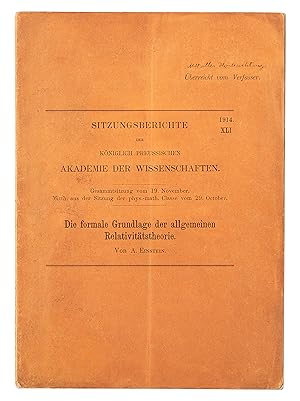
![Seller image for Autograph Letter Signed [ALS] Denouncing Racial Segregation for sale by Manhattan Rare Book Company, ABAA, ILAB](https://pictures.abebooks.com/inventory/md/md30742309183.jpg)
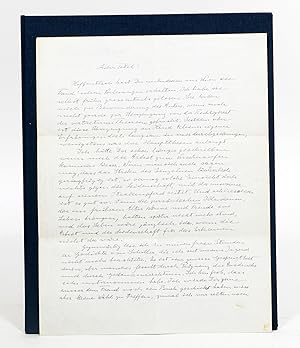
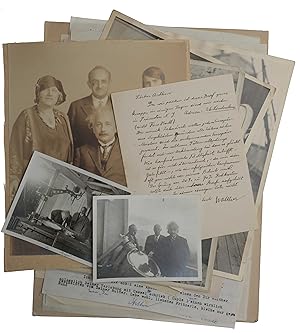
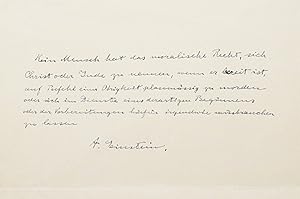
![Seller image for Einstein at Work [Suite of Seven Photographs] for sale by Manhattan Rare Book Company, ABAA, ILAB](https://pictures.abebooks.com/inventory/md/md31326176817.jpg)
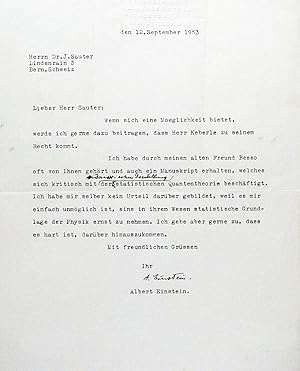
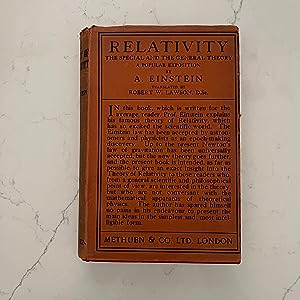
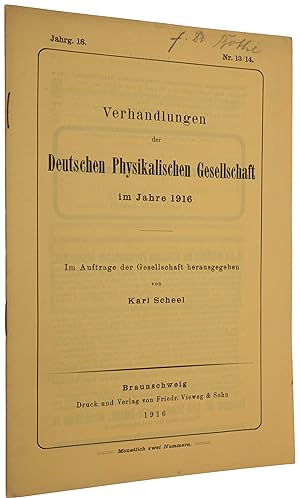
![Seller image for Zur allgemeinen Relativitätstheorie [with:] Zur allgemeinen Relativitätstheorie (Nachtrag). Offprint from Sitzungsberichte der Preussischen Akademie der Wissenschaften XLIV, November 4, 1915 & XLVI, November 11, 1915 for sale by SOPHIA RARE BOOKS](https://pictures.abebooks.com/inventory/md/md31360305474.jpg)

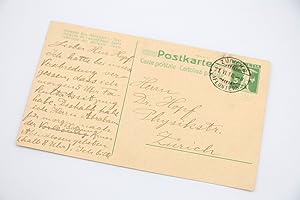

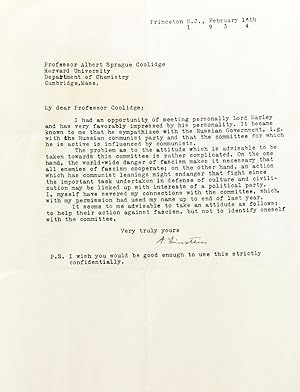
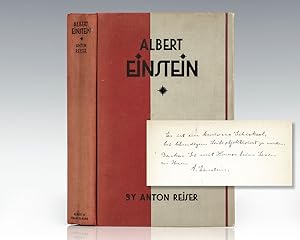
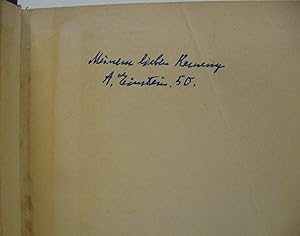
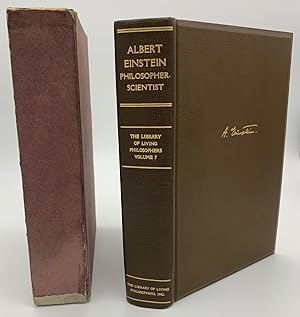


![Seller image for Über die Möglichkeit einer Welt mit konstanter negativer Krümmung des Raumes [with] Bemerkung zu der Arbeit von A. Friedmann Über die Krümmung des Raumes; in Zeitschrift für Physik for sale by Biblioctopus](https://pictures.abebooks.com/inventory/md/md31426029403.jpg)
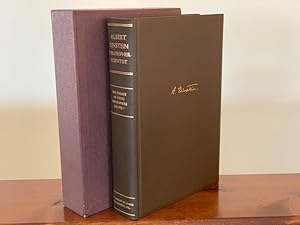
![Seller image for Albert Einstein. A Biographical Portrait. By Anton Reiser [pseudonym of Rudolpf Kayser, translated anonymously by Louis Zukofsky] for sale by James Cummins Bookseller, ABAA](https://pictures.abebooks.com/inventory/md/md31706909962.jpg)
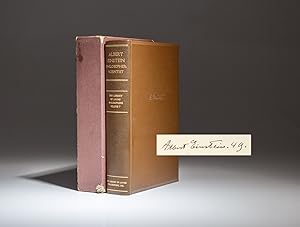
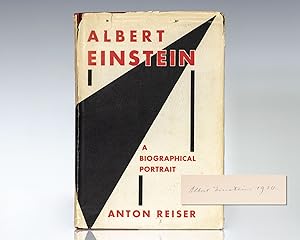
![Seller image for Über das Relativitätsprinzip und die aus demselben gezogenen Folgerungen [On the Relativity Principle and the Conclusions Drawn from It] for sale by Manhattan Rare Book Company, ABAA, ILAB](https://pictures.abebooks.com/inventory/md/md31092029978.jpg)


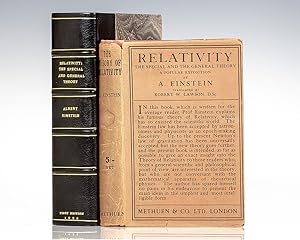
![Seller image for Strahlungs-Emission und -Absorption nach der Quantentheorie [Emission and Absorption of Radiation in Quantum Theory] for sale by Manhattan Rare Book Company, ABAA, ILAB](https://pictures.abebooks.com/inventory/md/md30695095102.jpg)
